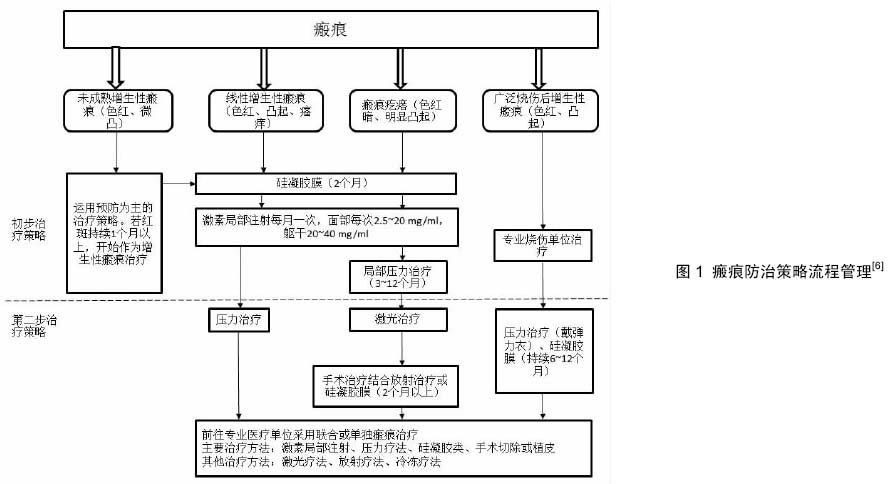| [1] 陈惠平,张余光,张涤生,等.创伤后瘢痕的临床评估及综合治疗[J].整形再造外科杂志,2004,1(2):113-117.
[2] Monstrey S, Middelkoop E, Vranckx JJ, et al. Updated Scar Management Practical Guidelines: Non-invasive and invasive measures. J Plast Reconstr Aesthet Surg. 2014;67(8):1017- 1025.
[3] 黄国锋,夏照帆.瘢痕防治的临床方案及国际推荐意见[J].中华烧伤杂志,2011,27(3):240-242.
[4] 胡大海,刘佳琦.伍重道远.进一步加强瘢痕的基础与临床研究[J].中华烧伤杂志,2011,27(6):407-410.
[5] Hinz B. Formation and Function of the Myofibroblast during Tissue Repair. J Invest Dermatol. 2007 Mar;127(3):526-537.
[6] Mustoe TA CR, Gold MH, et al. International clinical recommendations on scar management. Plast Reconstr Surg. 2002 Aug;110(2):560-571.
[7] Atiyeh BS EKA, Dibo SA. Pressure garment therapy (PGT) of burn scars: evidence-based efficacy. Ann Burns Fire Disasters. 2013 Dec 31;26(4):205-212.
[8] Khatri KA, Mahoney DL, McCartney MJ. Laser scar revision:A review. J Cosmet Laser Ther. 2011;13(2):54-62
[9] Ozog DM, Liu A, Chaffins ML, et al. Evaluation of Clinical Results,Histological Architecture, and Collagen Expression Following Treatment of Mature Burn Scars With a Fractional Carbon Dioxide Laser. JAMA Dermatology. 2013;149(1): 50-57.
[10] Son D, Harijan A. Overview of Surgical Scar Prevention and Management. J Korean Med Sci. 2014;29(6):751-757.
[11] Ren HT, Hu H, Li Y, et al. Endostatin inhibits hypertrophic scarring in a rabbit ear model. J Zhejiang Univ Sci B. 2013; 14(3):224-230.
[12] Gauglitz GG, Korting HC, Pavicic T, et al. Hypertrophic Scarring and Keloids: Pathomechanisms and Current and Emerging Treatment Strategies. Molecular Medicine. 2011; 17(1-2):113-125.
[13] 李曾慧平,冯蓓蓓,李奎成,等.烧伤后增生性瘢痕压力治疗及相关研究[J].中华烧伤杂志,2010,26(6):411-415.
[14] Huang D, Liu Y, Huang Y, et al.Mechanical compression upregulates MMP9 through SMAD3 but not SMAD2 modulation in hypertrophic scar fibroblasts. Connect Tissue Res. 2014;55(5-6):391-396.
[15] Costa AM, Peyrol S, Pôrto LC,et al.Mechanical forces induce scar remodeling, Study in non-pressure-treated versus pressure-treated hypertrophic scars. Am J Pathol. 1999; 155(5): 1671-1679.
[16] Brissett AE, Sherris DA. Scar contractures,hypertrophic scars, and keloids. Facial Plast Surg. 2001;17(4):263-272.
[17] 李俊男,刘流.聚硅酮在瘢痕防治中的作用机制和应用[J].医学综述,2009,15(18):2760-2762.
[18] 陈灵,农晓琳,陈翔,等.硅酮凝胶喷雾剂局部喷涂对兔耳增生性瘢痕影响的实验研究[J].中国临床新医学,2012,05(5):393-396.
[19] 李曾慧平,刘颂文,励建安,等.压力治疗及硅酮敷料治疗对增生性瘢痕疗效的短期研究[J].中华物理医学与康复杂志,2004,26(8): 462-465.
[20] Manuskiatti W, Fitzpatrick RE. Treatment response of keloidal and hypertrophic sternotomy scars:comparison among intralesional corticosteroid, 5-fluorouracil, and 585-nm flashlamp-pumped pulsed-dye laser treatments. Arch Dermatol. 2002;138(9):1149-1155.
[21] Manstein D, Herron GS, Sink RK, et al. Fractional photothermolysis: a new concept for cutaneous remodeling using microscopic patterns of thermal injury. Lasers Surg Med. 2004;34(5):426-438.
[22] Kunishige JH, Katz TM, Goldberg LH, et al. Fractional photothermolysis for the treatment of surgical scars. Dermatol Surg. 2010; 36(4):538-541.
[23] 谭军,李高峰,吴东辉,等.点阵激光治疗面颈部浅表性瘢痕疗效观察[J].中国美容医学,2008,17(10):1508-1509.
[24] 鲍卫汉,徐少骏.激素治疗瘢痕的机理研究[J].中华外科杂志, 2000, 38(5):378-381.
[25] Reish RG,Eriksson E. Scar treatments:preclinical and clinical studies. J Am Coll Surg. 2008;206(4):719-730.
[26] 赵贤忠,孙记燕,葛永亮,等.瘢痕移除后瘢痕皮回植原位皮肤再生治疗增生性瘢痕[J].中国组织工程研究与临床康复, 2010, 14(18): 3327-3330.
[27] 刘海兵,唐丹,曹海燕,等.温哥华瘢痕量表的信度研究[J].中国康复医学杂志,2006,21(3):240-242.
[28] Tyack Z, Simons M, Spinks A, et al. A systematic review of the quality of burn scar rating scales for clinical and research use. Burns. 2012;38(1):6-18.
[29] Oliveira GV, Chinkes D, Mitchell C, et al. Objective assessment of burn scar vascularity,erythema,pliability,thickness, and planimety. Dermatologic surgery. 2005;31(1): 48-58.
[30] Sullivan T, Smith J, Kermode J, et al. Rating the burn scar. J Burn Care Rehabil. 1990;11(3):256-260.
[31] Nedelec B,Shankowsky HA, Tredget EE. Rating the resolving hypertrophic scar: comparison of the Vancouver Scar Scale and scar volume. J Burn Care Rehabil. 2000; 21(3):205-212.
[32] Nedelec B, Correa JA, Rachelska G, et al. Quantitative Measurement of Hypertrophic Scar: Interrater Reliability and Concurrent Validity. J Burn Care Res. 2008;29(3):501-511.
[33] Fearmonti R, Bond J, Erdmann D, et al. A Review of Scar Scales and Scar Measuring Devices. Eplasty. 2010;10: 354-363.
[34] Vercelli S, Ferriero G, Sartorio F, et al. How to assess postsurgical scars: A review of outcome measures. Disabil Rehabil. 2009; 31(25):2055-2063.
[35] MB vdW, WE T, MC B. Rasch analysis of the Patient and Observer Scar Assessment Scale(POSAS)in burn scars. Qual Life Res. 2012;21(1):13-23.
[36] Brusselaers N, Pirayesh A, Hoeksema H, et al. Burn Scar Assessment: A Systematic Review of Different Scar Scales. J Surg Res. 2010;164(1): 115-123.
[37] Cheng W, Saing H, Zhou H, et al. Ultrasound assessment of scald scars in Asian children receiving pressure garment therapy. J Pediatr Surg. 2001;36(3):466-469.
[38] 陈惠平,张余光,钱云良等.瘢痕的临床评估[J].中国美容医学, 2004,13(6):751-752.
[39] 杨传晶.增生性瘢痕成熟度定量测量仪的色度与硬度开发[D].中山大学, 2010.
|
